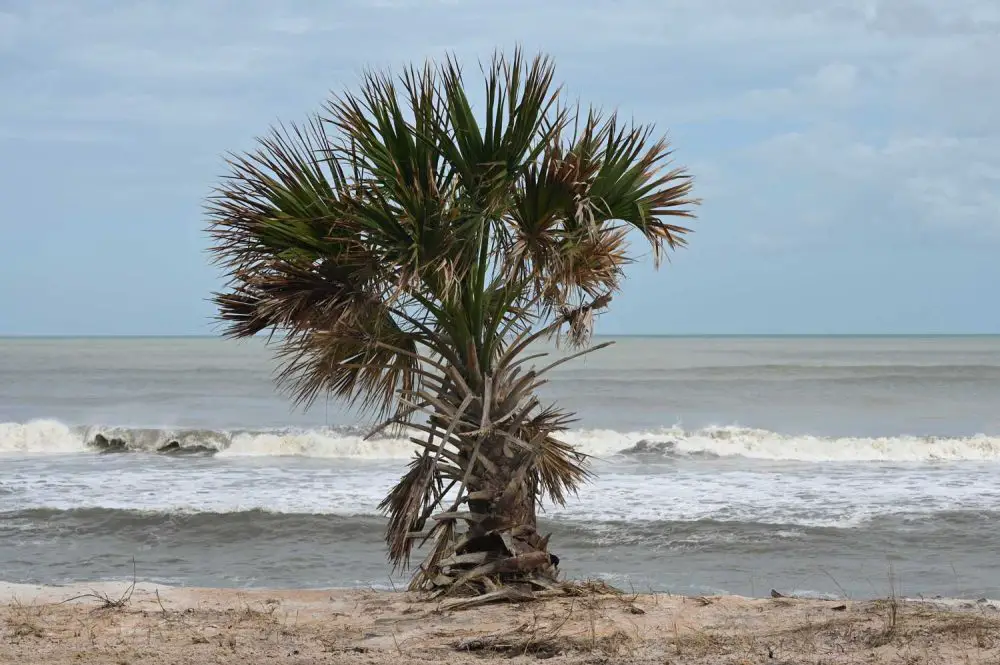
| Hurricane Nicole coverage: Monday | Tuesday | Wednesday | Thursday | Damage assessment, Part I | Damage assessment, Part II | A1A Reopens |
A FlaglerLive Special Report
There’s a palm tree somehow still standing on a dune at the south end of the county, near the Volusia County line. From the road, it looks as if it’s standing on air, with nothing behind it but ocean. And in fact it mostly is. That it was still standing early this afternoon was inexplicable. Three quarters of its formerly root-splayed trunk base was exposed and rootless, the leeward side of bulge barely holding on to what’s left of a threadbare shelf of sand. It used to be a dune. Now it looks like something a child built to to look like the ramparts of a sandcastle, enjoying its brief moment in the sun before it’s washed away.
The tree isn’t going to be there long. It’ll be buried by a truckload of sand or felled by the next gale, the next high-tide wave. That tree summarizes the shock of Tropical Storm Nicole on Flagler County’s shoreline. It symbolizes how much was lost, and how much what remains is clinging by threads.
As in the aftermath of Hurricane Ian, the effects of Tropical Storm, Nicole on Flagler County are a tale of two storms. There was no loss of life. There were no injuries. But for two dozen rescues from flooded homes in Flagler Beach on Thursday, there were limited human impacts. In Palm Coast and Bunnell, the storm might as well have been an extended summer storm. Measured by direct property damages, the county is estimating countywide costs to private property owners of $23.7 million, a relatively modest sum that risks downplaying the true effects of the storm. (Insured losses from Hurricane Ian range between $53 and $74 billion statewide).
Public losses, not including beach and pier costs, amount to $5.6 million, according to Jonathan Lord, the county’s emergency management director.

But as with Ian, the most severe damage was along the coast, below and mostly out of eyesight. It was along State Road A1A, which was severely chopped up in numerous places. It was below A1A, where there’s little left to prop up the road. It was on beaches whose sands in massive amounts have encroached on homes and entombed some of them, as in northern Flagler County, where back porches are now part of the beach. It was in how a long lines of homes at the south end of the Hammock are now teetering on cliffs of sand, much like that palm tree, with nothing so much as a dune remnant protecting them or holding them up.
It was how the storm so radically remade the beach that for the first time in memory, the beach in front of Hammock Dunes Club and as far as the eye could see north and south of it, was studded today with the return of coquina rocks ripped from resting places elsewhere along the coast. None of this is normal.

None of it is minor. It signals far more momentous consequences to the viability of Flagler’s shoreline, the nerve center of the county’s tourist economy, and heightens the urgency for action by the county on its beach management plan–action that has so far been woefully wanting beyond the words and promises of slumbering elected officials as staffers plead for action. Flagler Beach and Flagler County officials knew how vulnerable the shoreline was even before Ian, the county’s $18 million dune rebuilding project of 2018 having mostly evaporated by then. They knew how more vulnerable the shoreline became after Ian. But for DOT’s vain effort to dump sand at the south end of the county, they did nothing.
Nicole’s catastrophic effects on the beach are not a surprise. They were predicted by the same officials and their staffers.
FlaglerLive surveyed the Flagler coastline from north to south in the aftermath of Hurricanes Matthew and Irma, and in the aftermath of Hurricane Ian. It did so again today, including walks the length of beach and (closed) road from the Flagler Beach water tower to the Volusia County line, a mile-and-a-half length of beach south of Varn Park in the Hammock, shorter lengths around Hammock Dunes–an anachronistic name anymore–and between Moody Drive and Rollins Drive at the northern end of the county. The following, in pictures and video, is the result.
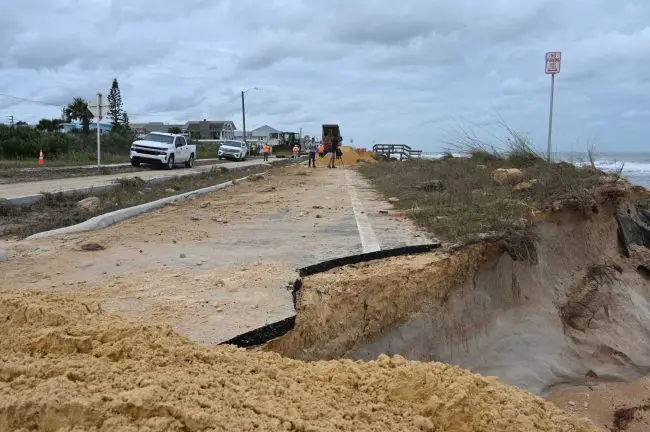
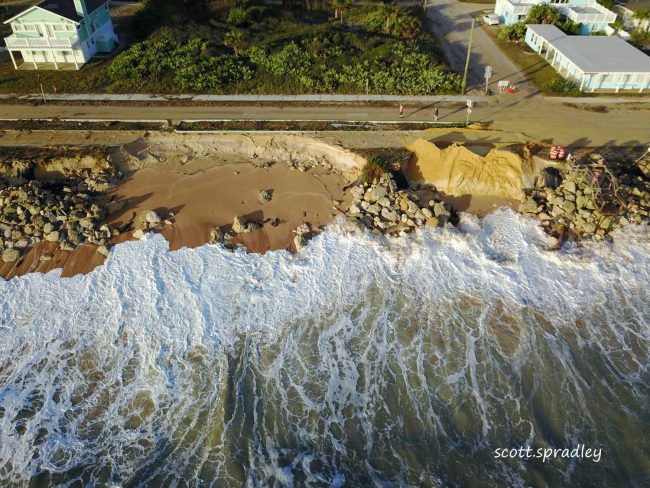
Residents quickly became familiar with the numerous gaping carve-outs of State Road A1A in Flagler Beach proper, including those near 13th Street South and 17th Street South, which cut out the entirety of the northbound lane up to the median and its French drain system. Since Thursday, even as the storm was still raging, the Department of Transportation contracted with paving and trucking companies to fill in the carveouts “using thousands of [cubic] yards of granular fill being hauled in by dozens of dump trucks,” according to a DOT spokesperson, “so that S.R. A1A can be reopened to traffic as quickly as possible.”
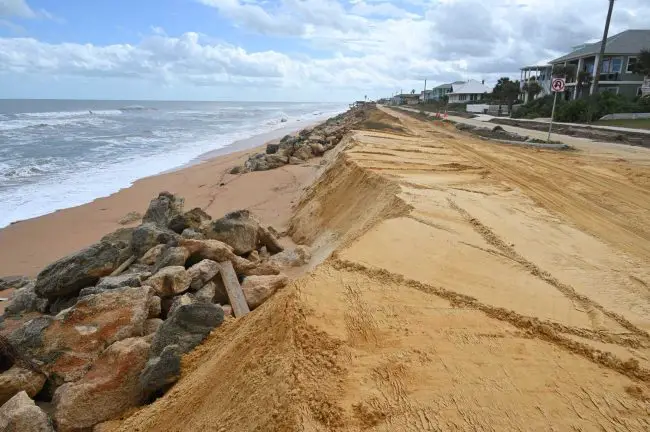
Dump trucks took to South Central Avenue all day, rumbling north and south in what may have been an aggravation to residents but was more like music to those more aware of the trucks’ immediate benefits. Those carveouts looked all, or almost all, filled in today in all three areas severely impacted:
- A1A from South 28th Street to South 7th Street in Flagler Beach.
- A1A from Highbridge Road in Volusia County to South Flagler Beach in Flagler County.
- A1A from Wisteria Drive to Sunny Beach Drive in Ormond by the Sea.
State Road A1A from the Volusia County line north to the Flagler Beach tower, and again from South 20th Street to South 5th, is now a roadbed without a bedframe. It has lost its bracing of coquina rock or vegetation, or both (as in the area at the south end of the county), on its east side in many spots. While the carve-outs have been patched with remarkable speed, the durability of the fix is questionable. Even today, some of the new sand was being eroded.
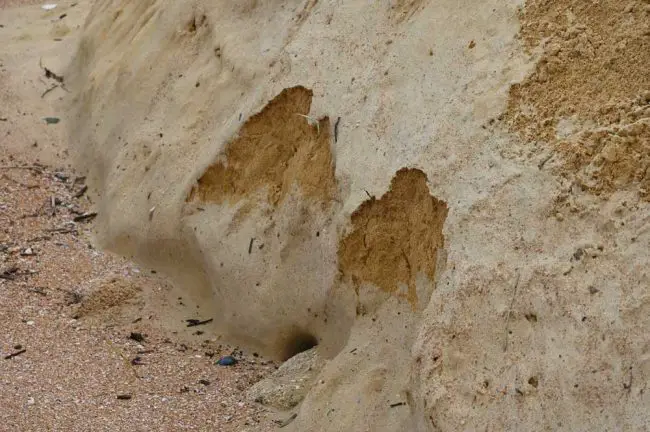
Flagler County and Flagler Beach officials have been almost boasting about how the Department of Transportation’s sea wall held up at the north end of town, and how limited to nonexistent the damage was north of 5th or 6th Street North and into Beverly Beach. Perhaps they haven’t looked closely enough. The sea wall held. That’s beyond question. But north and south of it, there is hardly any vegetation or dune definition to speak of anymore. The beach slopes up to the A1A roadbed, with nothing impeding the next unusual high tide coupled with stormy seas to wash over A1A and keep going west.In those areas, the almost non-existent barrier between the beach and the road is similar, if slightly more sloped and still more verdant, than south of the water tower, where all definition has disappeared. Here’s a series of pictures illustrating the damage and vanished dunes at the south end of the county:
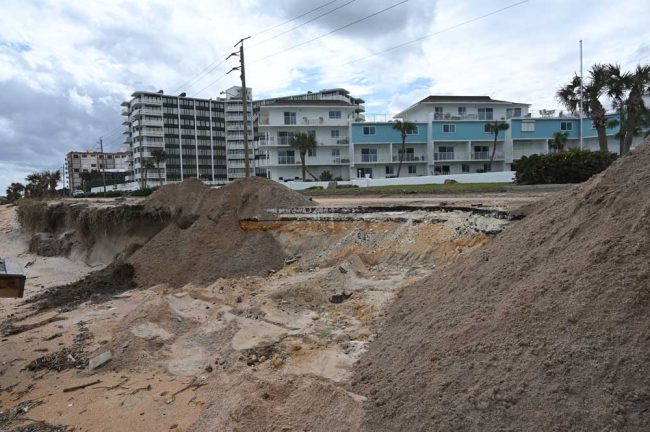
Here’s a sequence of three pictures–before, during and after the storm. The first picture was taken on Nov. 4, as DOT was still dumping thousands of cubic yards of white sand on that same stretch of road:
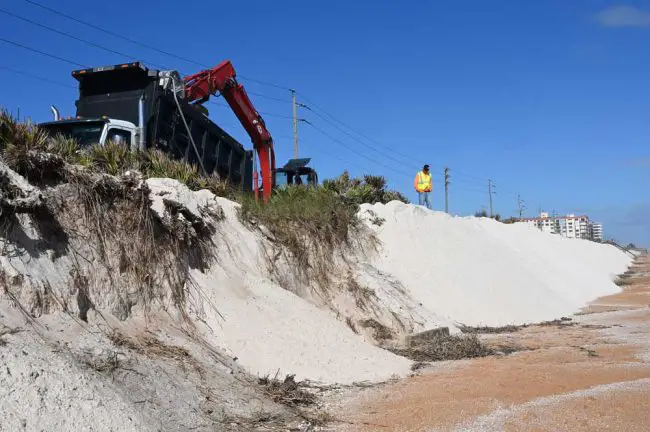
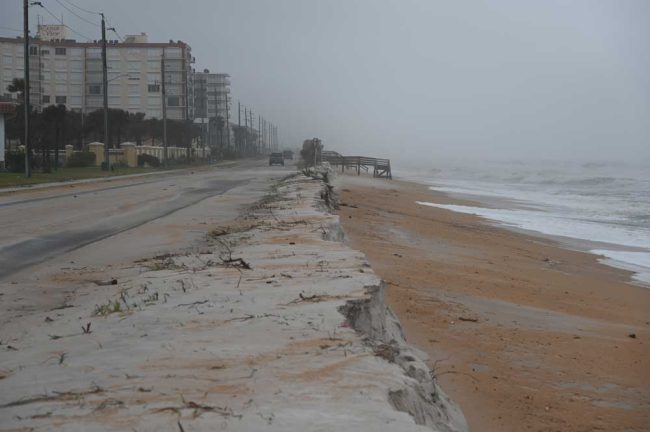
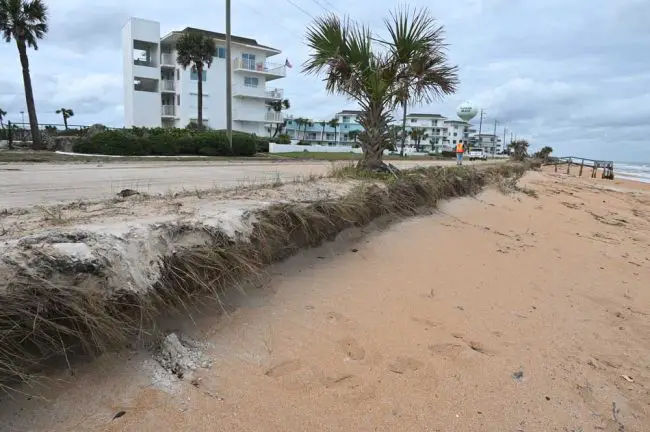
Today, DOT trucks were back to dumping sand in the same areas, but mostly to patch up carve-outs.
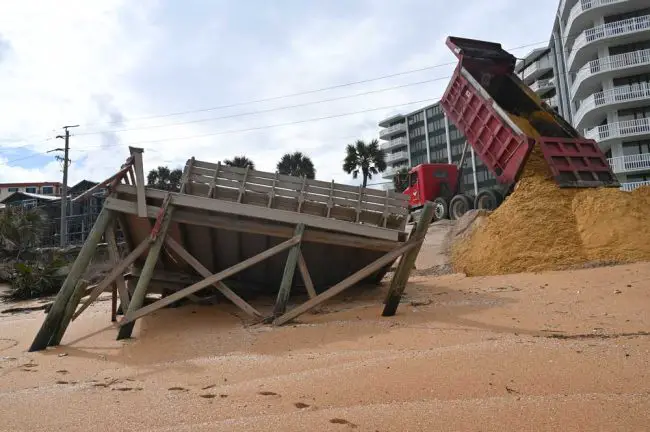
Here’s a video of that stretch of beach and Nicole’s damages:
Going north past the damaged section of A1A in Flagler Beach and into the heart of town, the most striking damages are an accentuation of what had already been taking place even before Ian, rather than a radical change: the dunes north of the pier have not only vanished. The remaining sands and vegetation that had clung on to the ramparts of A1A are gone, leaving nothing between the beach and the road but crumbling concrete and a boardwalk that somehow manages to remain anchored even as its piles are bare. This is a picture of the beach after the city was stunned by a massive loss of dunes in late summer, but when there still were a substantial dune structure protecting A1A:

Here’s that stretch of beach today:
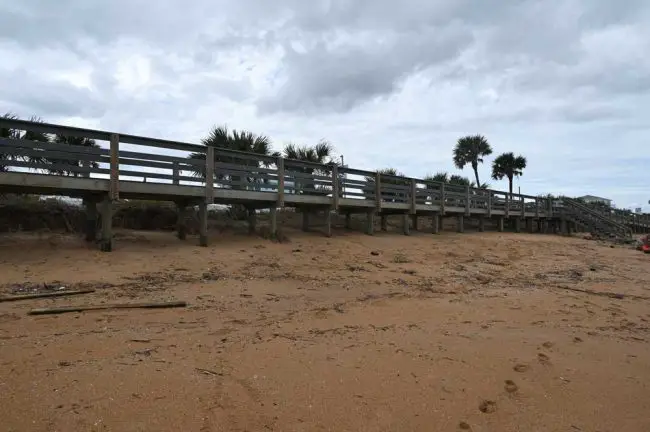
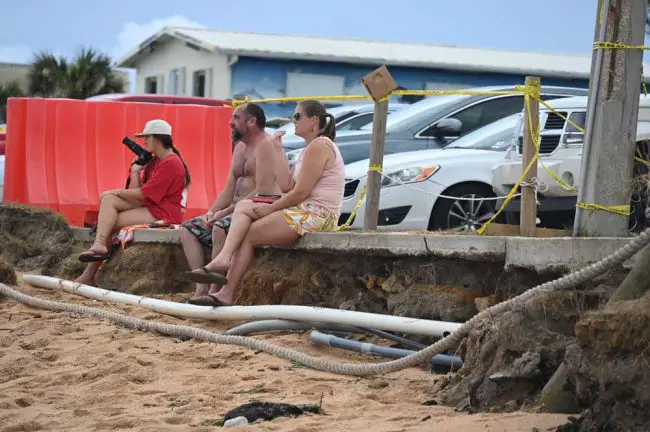
At the north end of Flagler Beach, the erosion is less eye-catching because it hasn’t caused any carveouts, and because the sea wall has protected the road. But the same massive loss of dune sand evident in the center of town is just as evident at the north end of town, with fewer landmarks to delineate the loss. Instead, the beach is now a direct slope from State Road A1A down to the beach, with straggly vegetation instead of the lush greens and palmettos of old:
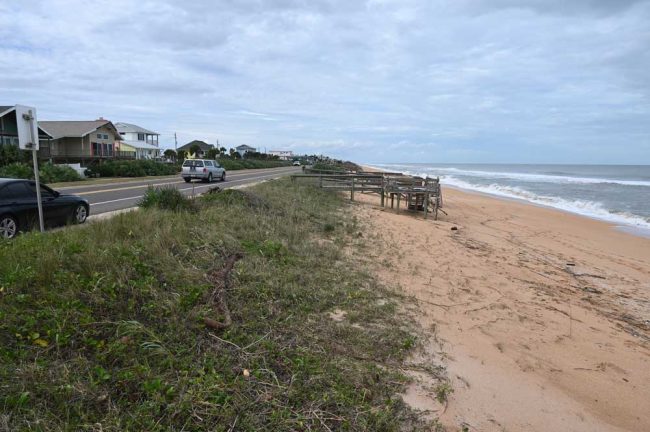
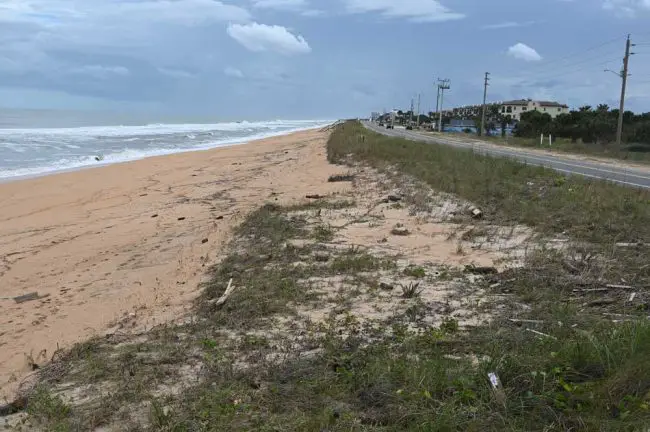
Get past Beverly Beach and into the Hammock, and it is nothing short of a disaster zone on a time clock. Almost every house south of Varn Park for about a mile and a half stretch is as if on a cliffside of sand.
Brian Walsh built the multi-level house at 3461 North Oceanshore Boulevard two years ago. The house is valued at $1.1 million. There was a 35-foot stretch of dunes and vegetation between the house and the ocean when he built it, he said. Today, it is all gone. He knows of the property owners further south who got the county to build a seawall in front of their properties, with the owners themselves footing the bill. Walsh wonders why there’s been no similar initiative by the county to protect his and neighboring properties. He says it’s shortsighted, because the loss of those properties would hurt the tax base and the county’s tourism.
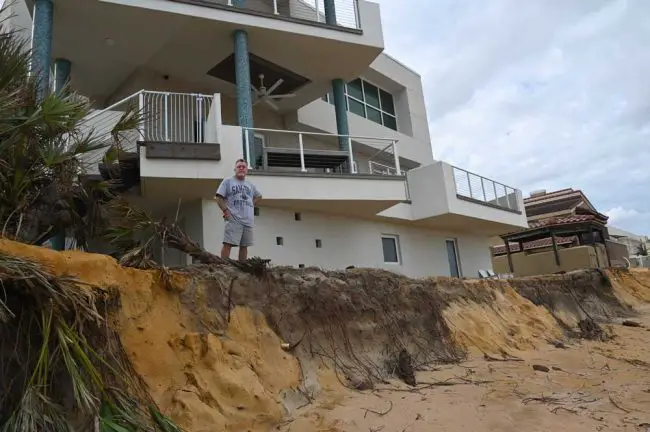
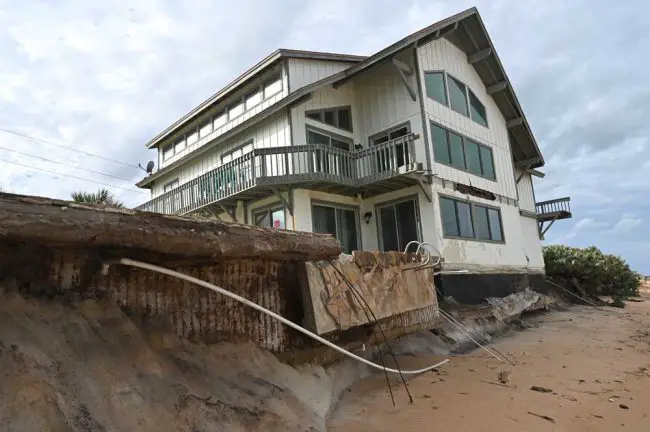
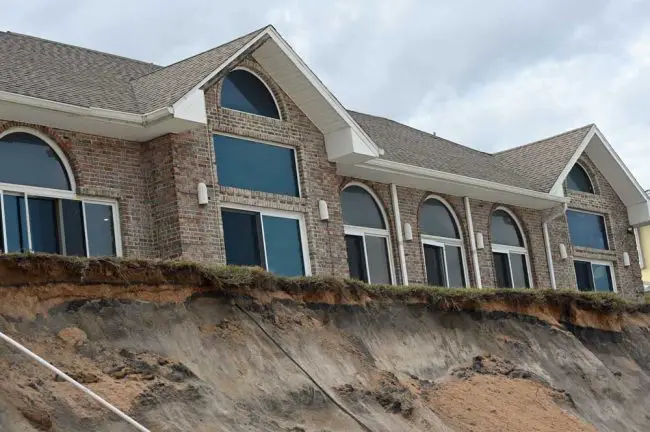
here’s a video of the damage south of Varn Park:
Over the years, and since before Hurricane Matthew, FlaglerLive has taken photographs of the dunes at Varn Park to document the loss of sands. Here’s a sequence showing the loss over the years, from 2011, to Matthew in 2016, to Ian this year to today:
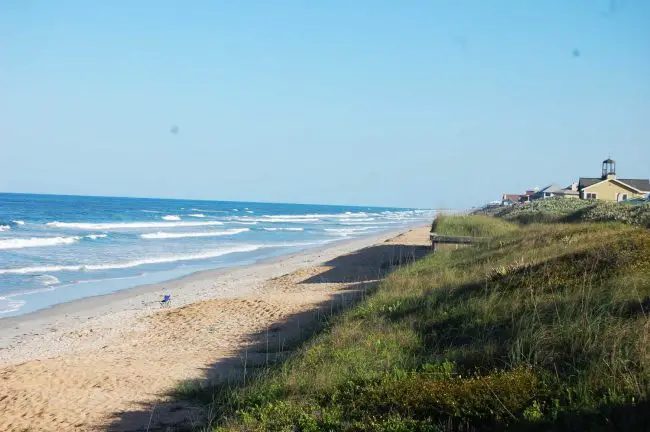
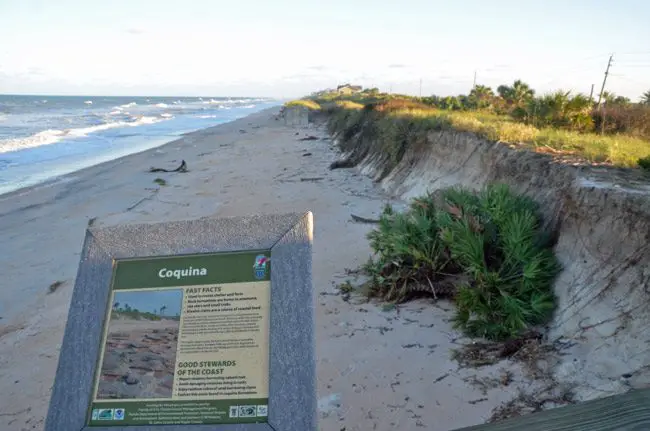
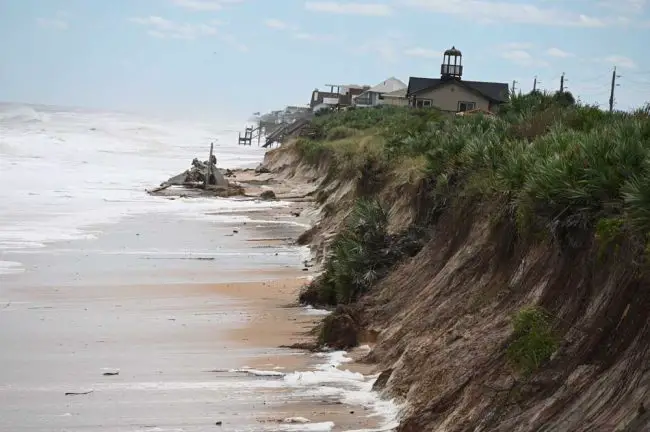

There are now three breaches in what remains of the dunes at Varn Park itself, through which any storm surge would flow. A worker on a backhoe was plugging a similar breach further south today, between built-up homes.
At the beach in front of Hammock Dunes Club, a similar loss of dunes has reduced the demarcation between the club’s most ocean-side buildings and the beach. Only months ago it was impossible to stand on the beach and see more than the upper floors of the building. Today, between an onslaught of sand (and those coquina rocks) and the leveling of what had been protective dunes, there is almost no demarcation, and barely a drop off between the club’s grounds and the beach, where proles of Old Salt park and Hammock Beach guests have much less separating them.
Further north between Bay Drive and Oceanside Drive, it’s a similar remaking of the landscape. Al Hadeed, the county attorney, on Thursday had described the transformation of Oceanside Drive into a river of oceanwater as the Atlantic flowed freely inland and down the small subdivision of hardy residents who like the area’s frontier feel, who–many of them–build homes high on piles, and who know they’ll have to contend with the occasional flood. But it’s been progressively worse since Ian, with crippling floods, and now, a literal invasion of the shore onto homes.
At the end of Moody Drive, Atlantic Drive, Flagler Drive, on the oceanside, those streets have been entombed in up to three feet of beach sand for about 30 to 40 yards inland after massive waves washed onshore and beyond. Instead of getting buried in a snowstorm, houses got buried in a wet sandstorm, like the house at the end of Moody Drive.
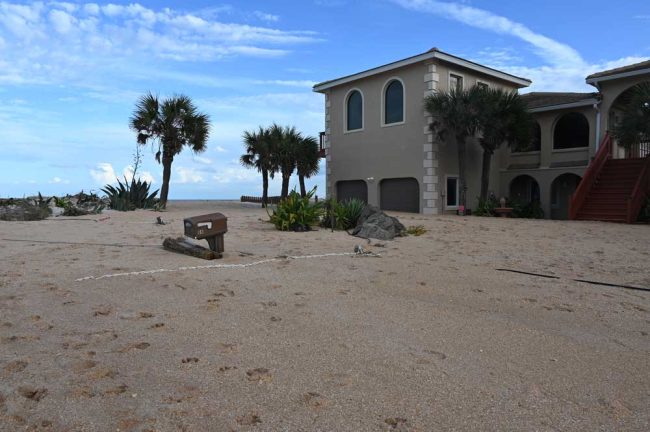
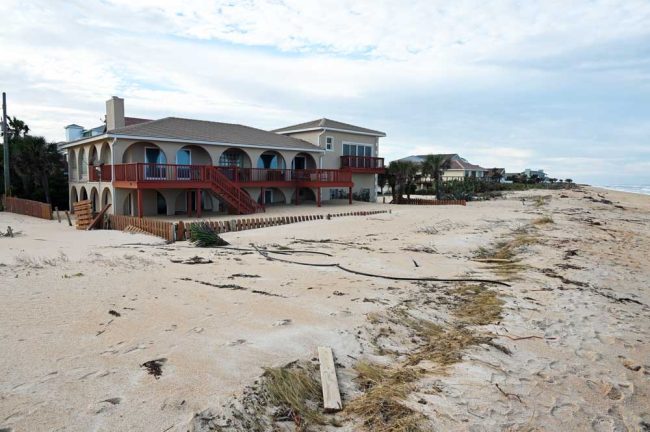
A few houses down, Peter Hopfe’s family and friends were busy digging out of the storm, sand having encircled the house and blocked the garage, with floodwater adding to the burdens. A long hose piped floodwater to the ocean as Hopfe’s son worked on the oceanside of the house, attempting to rediscover some definition between shore and property. Hopfe built the house three decades ago and envisioned it as his retirement home, his son said. But storm after storm since Matthew has been challenge after challenge, even for an athlete. Hopfe, a long-distance runner, coaches cross-country at Embry Riddle. The last few years have been a different kind of marathon.
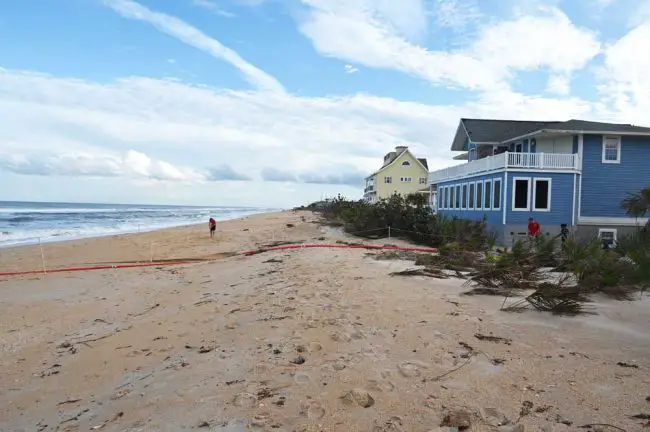
There had once been a concrete sea wall or retention wall at Varn Park, of about 100 feet in length. It was demolished after Hurricane Matthew, and further broken apart in subsequent storms. Today, all that remains is a broken slab that looks like the monolith at the beginning of Stanley Kubrick’s “2001” after a very bad time. But it also seemed to stand as an echo of the tree at the south end of the county. Trees and walls can grow oceanside. Sooner or later, the ocean gets other ideas.
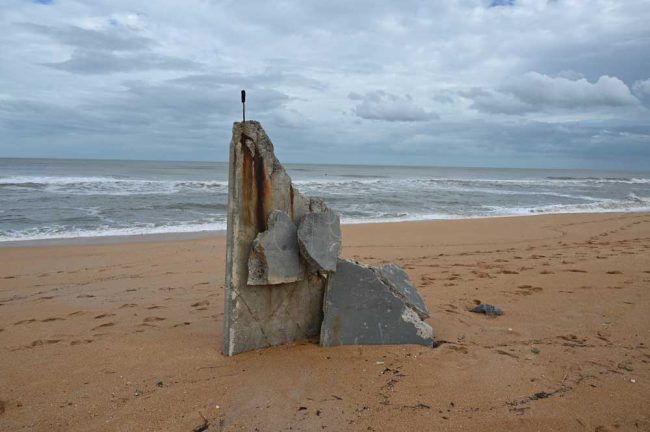




























Willy Boy says
… a foolish man who built his house on sand. Matthew 7:24-27
Dianne says
I had thought about theat scripture to.
However mankind has free will so build on sand or rock either way it’s our choice.
All those living inland made their choice so worrying about large increases in insurance premiums isn’t helpful. Maybe a move to Alaska and go off grid would solve all those worries.
Doug says
Welcome to Florida, where Mother Nature doesn’t discriminate. I have zero sympathy for those who opted to buy and build their multi-million dollar homes on the dunes, all for a view. My only concern is that I hope the outrageous claims for their stupidity don’t affect my annual insurance rates or cause insurance companies who insure in Florida and this area to not pull out of the state.
Joe D says
I’m afraid BOTH your fears are going to come true!
This Summer, Security First wanted to cancel my
Policy, because I could not prove my roof was less than 10 years old. New estimates went from $2600–> $4300! Most insurance Companies are not even writing Florida homeowners policies ( mainly due to the number of law suits from some dishonest roofing contractors, through a Florida law loophole). My 2 BR /1.5 BA 1175 sq foot 20 ft above sea level, elevated, poured concrete with concrete slab floors and roof, townhouse on the western side of A1A facing the beach, has NEVER had any damage due to its “fortress” construction in late 1970’s. I had to pay $500 in special inspections to prove its concrete slab roof and poured concrete walls (inside and out) had no increased risk, and never needed replacement!
The new company agreed with the inspector and the information on the townhouse construction supplied by the HOA, so my policy dropped back to $2600 with a $5000 hurricane deductible (whew)!
However, next year you can surely expect to absorb a portion of the Florida west coast damage cost increase spread among ALL residents. I spent 20 years looking for a property that would avoid not only wind, but flooding waves! I simply can’t understand (after the storms of the 1970’s and 1980’s), why new $million construction would not mandate 10 ft plus elevation above sea level? Wind mitigation isn’t the only risk (as we have now seen with both Ian AND Nicole)
We can also expect, after all the insurance settlements are done, there will be still fewer Insurance companies in Florida!
The STATE run program is likely to bankrupt their funds, and the state has a provision to add a surcharge onto YOUR private policies, if they drop below a certain level of solvency in their system. Along with the $500/ year property taxes every year since 2019, soon, I will no longer afford to live in Flagler Beach…how SAD!
Laurel says
Doug: Some of you sound like broken records. I don’t live on the beach, but to me, those of you who keep calling people stupid for building for the view, just sound jealous. Seriously. I know damn well, if y’all had the cash, you’d be there too.
Also, if any of these houses are insured, and I’m sure many are not, it’s at a much higher premium than the average house. They pay much higher annual taxes as well. Insurance rates also go up with inland flooding, sink holes, fires, tornadoes and mudslides, depending where you live.
Welcome to climate change, that we all participated in and all will pay for.
Doug says
Laurel: other than what I wrote, you don’t know me. I saw what hurricane Andrew did to the makeup of South Florida and the result of insurance claims, premium price increases, insurance cancelations, and companies moving out of Florida. I experienced it firsthand. As for the comment, “I know damn well, if y’all had the cash, you’d be there too.” Wrong. I’m comfortably retired and live in the home I grew up in on the Intracoastal. It was built like a “fortress” in 1978 and has survived many storms. I could sell and be like one of the many who recently moved here and have that view you speak of; however, I wouldn’t have it gifted to me.
If you have not, I encourage you to visit the Flagler County Historical Society. They have many photographs of the Flagler Beach coastline from the 1930s. It was about the same then as it is now. So, I don’t believe your “climate change” comment has much credibility, although weather patterns might be a better explanation.
Skibum says
Laural, I have to respectfully disagree with your suggestion that Joe and the rest of us (y’all) are just jealous of you and others who chose to build right on the beach. And if we all had the cash to do so, we would have built right on the beach just like you. Sorry, but that is just an ignorant comment that I would have expected to have come from the likes of Leona Helmsley… you know the one who infamously said that “only the little people pay taxes.” I could easily make a very broad-brush comment that would be just as incorrect by suggesting that everyone who builds right on the beach is brainless and teasing financial disaster. Whatever your motivation was, many of us who moved to this area and either bought or built their homes know the increased risks associated with owning a home so close to the ocean. In my more than 30 years of growing up and living on the west coast before retiring and moving here, I have always lived very close to the ocean, having lived in Laguna Beach and Morro Bay in CA, and then later on the outskirts of Seattle, WA near the coastal waters of Puget Sound. But I have chosen, wisely I believe, to never live right on the ocean’s edge. I’m sure there are many others who love to look at and visit the ocean, eat and recreate near it, but who have made a deliberate and well thought out decision not to own a home there for many reasons that should be obvious to anyone considering all of the risks, including financial loss. While I could have afforded to do what you did had I a mind to, the risk of loss and the exorbitant cost of maintaining a beachside home was a no-brainer for me, as I’m sure it was a primary consideration for many others who thought better of such a location. To suggest otherwise is ridiculous.
Doug says
Skibum – according to her post, Laurel says she doesn’t live on the beach.
Laurel says
Doug: Hahahaha! Thank you! Skibum called me ignorant, yet he chose to ignore what I wrote and instead, knew just what kind of person I was, and went on and on about it. He compared me to a cranky, rich person, like Helmsly, which is interesting. My favorite store to shop in is the Flagler St. Vincent de Paul Thrift Shop!
I too remember what Andrew did. I was living in Boca Raton at the time, and had lived in South Florida all my life up until a dozen years ago and moved here. If you recall, the damage Andrew did was devastating to groups of houses by neighborhoods. There would be a total wipe out of a neighborhood, yet buildings right next to that, were homes still standing as if nothing much had happened. It was all about the building quality. It was after that Miami Dade changed the building codes, which are the standards of most of Florida. In the panhandle, they had so few hurricane hits that the Miami Dade codes were not applied. Same goes for most of the older homes on the west Florida coast.
Turns out, Doug, you are probably one of our neighbors. We, too, live on the ICW, in an elevated fortress. But I dislike many of other’s comments here, calling people fools and stupid. The people who do live on the beach are not known to these commenters, either. The nasty comments just sound jealous to me.
As for climate change, it’s real. If you look at the Earth from space, it is mind blowing just how thin the atmosphere is. Practically nothing. Trapping in the heat is making a difference. The Earth has changed in yours and my lifetime, and you know it. I remember reading about acid rain decades ago, and now the ocean is becoming acidic. Corals are dying. The Amazon Forrest is being cleared for charcoal and crops of single types of plants (potato famine anyone?), the lungs of the world, burning down. The bayous of Louisiana have been so polluted by industrial runoff, while the locals stood by thinking it’s okay as they will go to paradise when they die. It goes on and on. It’s real alright.
Susan says
Oh, it will, and that is my craw too. And if they have no insurance the government had better not give them any money. And you better believe our rates will go up too. Burns me to no end,
Deborah Coffey says
This is an excellent presentation. And, we should note that Nicole was not a Category 4 or 5. For the climate change deniers, this must be a real eye-opener. I can’t help wondering what is happening to the value of the houses and businesses on the other side of A1A. It’s all very sad and scary.
Ray W. says
Thank you, Deborah Coffey, for recognizing the quality of reporting and quantity of effort that Mr. Tristam puts into articles that impact all of us. I applaud Mr. Tristam, too. Thank you, Mr. Tristam.
FlaglerLive says
That’s immensely appreciated. Thank you.
Methuselah says
Nicole was just a tropical storm. Mother Nature has redefined the Florida coastline and will continue to march inland as the seas rise..
Mary Lumus says
How is this a shock. You build on the beach and this what happens.
Timothy Patrick Welch says
Nice documentation and comparison…
Ray W. says
Thank you, Timothy Patrick Welch, for the same reasons I thanked Deborah Coffey.
John Stove says
What did they think would happen when you only protect the shoreline with sand, a few rocks and dunes? You will never ever stop this unless you build an armored breakwater (seawall) to keep the worst of the tidal action and storm surge from causing significant damage.
You want your “ole timey” Florida beach?…..then this damage will continue to be an annual event with every Noreaster or Tropical Storm.
Derrick Redder says
Counties should Condem each parcel. Demolish and clean up then send the owners the bill. Leave the barrier island as a barrier not a vacation retreat or investment rental. Then Let them sue the government for compensation after the their private insurance pays out.
Joe D says
That’s one way to deal with poor NEW construction decisions, but you might have second thoughts, when you see what happens to you Flagler County taxes if the MASSIVE revenue and tax dollars/sales tax dollars generated by those TOURISTS, disappears with the beach….barrier island tourist $ cover a LARGE portion of the remainder of the county’s expenses….just pull up you County budget, and look at the revenue GENERATED column!
pete says
Do you want a road or water front homes. Pick one
Laurel says
Derrick: I bet you would feel a whole lot different if the government condemned, demolished, cleaned up and sent you the bill for your property. Yes, indeed. You would have a much different attitude.
These negative comments accomplish nothing.
Jimbo99 says
Time to fall back further & retreat. Unfortunate people have invested millions into that sand & their dwellings. It was a foolish bet. Homeowner’s Insurance crisis Biden inflation alone is unaffordable economic model devoid of any storm(s). The last dune rebuild was $ 25 million and it lasted maybe 2 years tops before Ian & Nicole. That was Trump era unaffordability. Why would anytone think that with the last 2 years of inflation that the pricing of an estimate of $ 25 million again is a rela number & adequate to get the next dune replenishment for Flagler county done in 2023 & the 2-3 years that’s going to take. The sand & dirt comes from elevations inland. 18 miles of coastline has to come from somewhere else since what was there is now a sandbar off shore. So that relocation of sand & dirt is now a liability further inland as any storms move through the state of FL. And guess what ? It takes fossil fuel not Biden’s EV fantasy to relocate that new dune. Where are the outcries of global warming & pollution. We’re back to the wealthiest being served, while the masses continue to fund & are underserved in this economic & financial Ponzi Scheme that has no solution. How many truckloads of sand were delivered by the decade plus year old Obama-Biden EV fantasy for the last dune replenishment ? I’ll say it for anyone loud & clear, not a single grain of sand. When we have a fool for a POTUS, the rest of it is the same old lies of stupidity. The propaganda is just astonishing.
Flagler Beach people are left to not understand why nothing is being done? Well these are the same idiots that sunk their wealth into those properties. It takes years to unmuck this mess. We aren’t but a few days removed from Nicole. The impatient need to file their claims, demolish what they built and find higher ground elsewhere. If that means they have to relocate, then so be it. This lots as empty are now only worth pennies on the dollar.
Remember the Flagler tourism center ? The best thing that could’ve happened, did. Another bought that land on the west side of A1A and now I bet with A1A in jeopardy, it’s worthless too. Yet somehow the Flagler Council wanted to pay 2021/2022 inflation on real estate for a vacant lot. Remind me again it was a $ 725K-1.5 million plus for that location ? Somehow I have to believe the Alfin is making the most of these sell you a bridge in the swamp land in FL opportunities ? Remember the moldy buildings, there was a wife that was getting a commission on every one of those moldy sales. Same story, progress doesn’t happen unless someone gets overpaid quite well.
https://flaglerlive.com/172280/county-flagler-beach-visitor-center/
https://flaglerlive.com/175776/tourism-land/
https://flaglerlive.com/179045/palm-coast-mayor-david-alfin-tpo/
Geri Kail says
You completely skip over the state government in order to blame Obama and Biden for this. Strains credibility. For many, many decades, Florida has encouraged extravagant building on barrier islands, for growth in tax base. When I was a child in Florida in the 50s and 60s, the barrier islands had small cottages and motels, structures that would not create enormous shared financial hardship if washed away. Now we have thousands of high rise condominiums and mansions on the sea. Instead of casting blame, let’s look at what the future of our beautiful state looks like, since that has become unsustainable. Unfortunately, it’s hard to get any government to plan for a future where financial sacrifice is necessary, as opposed to everyone rich getting richer. In closing, I must say that the lack of sympathy for others demonstrated in many of these comments is very sad.
Laurel says
Thank you Geri, both my husband and I grew up in Florida too. We very much remember the 50’s and 60’s as well. People here do not realize that much of what was built on the ocean was there for decades without issue, and like you wrote, they were mom and pop motels, not these monstrosities built later.
Kat says
Thoughtful insight, I appreciate your comments and each earlier posts commending Pierre for the quality of this article.
Steve says
Your continuous claims are laughable. Nice showing in the Mid Terms.
PS,,, Hope Folks get a grip on the Reality of the Future of this situation
Laurel says
Jimbo99: Your hero, Trump, has a home/country club on A1A, with a tunnel that goes under A1A to a guest beach house, with two swimming pools right on the beach.
tom dooley says
jimbo please run for any office of your choosing so america can vote for you. Your intelligent’s is mind blowing; you know so much please help all of us humans. We need your thoughtful inputs on this democratic blog website. What happened to the ozone layer jimbo? any thoughts I can use today? lol.
Ann Brisson says
High tide was 70 feet away when these properties were built.
Denali says
And Matanzas Inlet was two miles north of its current location a couple of hundred years ago. The point is that these are barrier islands which are by nature intended to be sacrificial. They are not and should not be considered as protection for man-made structures. Nothing man can do will change this fact of nature.
Tony says
Unlike other commenters, I have some sympathy for those who have had their property destroyed. It is always easy to comment what should have been done after the fact. Hindsight is always 20/20. To those who did not experience significant damage, count your blessings.
Joann says
Does anyone know the status of Snack Jacks?
FlaglerLive says
It survived Nicole better than Ian, repairs are ongoing. The building to its south–a motel–took the brunt of the damage during Nicole.
pete says
Your not going to win this one, it’s just a taste of what’s to come and all the money in the world is not going to stop it.
Mark says
For years many parts of the seaside stretch were barren for a reason except for smaller dwellings. The County should have never allowed many of these newer larger structures to be built on small lots. Going forward the County should just say no more building seaside unless the property owner builds a strong seawall at the owners cost.
pete says
No more building…….. end of program
Steve says
Well I have to agree. Spent 20 plus years in Jupiter, Fl. That’s exactly what they did. Stopped the Building for the most part along A1A many years ago and it’s helped.
Skibum says
I have made other comments regarding our recent storm, but one thing that continues to surprise me, and something that I have not noticed anyone else commenting about, is that it is still a head shaker for me to see the remaining length of the very damaged and condemned Flagler Beach pier still standing after the lashing from Nicole, when many well built structures all up and down the coast have been completely torn to shreds. Amazing!
William Moya says
What will the answer be, to build more sand dunes? Just curious.
Matt says
I really appreciate the top notch reporting I consistently see here. Thank you!
What Else Is New says
Thanks to Pierre Tristam for the continued excellent coverage of pressing needs in our county. Pierre’s reporting of our recent disaster along the ocean was outstanding. While one might have no sympathy for those who built houses near the ocean, at least have a heart for their suffering. I imagine they never dreamed the ocean would swallow up their homes. And I agree with those who blame the Planning Board and County Commission for approving every kind of development on this barrier island. Money talks, folks.
ASF says
Wasnklt there a lone hold-out property owner who has been boggling up the works for Federal conservation reflief efforts for years now?
If that is still causing an issue, no is the time to adress it–if it isn’t already too late.
Joe D says
The town wanted to build a concrete seawall with 26 ft deep pylons along the southern end of town, like there is to the north end of town. However, since most of the beaches are “privately owned ” by the homeowner facing the beach, the local and state attorneys needed to get permission (an “easement “) to essentially legally enter the property to install the same type of seawall (post Matthew) that was VERY successful in stopping flooding in the North end of town. REPORTEDLY, one (?) land owner continues (after several years) to refuse to agree to the beach access for seawall/pylon construction south of town. That left the only option being sand and rock dune reinforcement (and we saw how well THAT held after Ian). It was known that ANY significant water level increase with a storm (and at KING TIDES yet!) would flood the south of town, because there was NO protection after Ian. It does look like the Town/State are now pursuing the legal process of EMINENT DOMAIN. A process where a government project determined to be for the “good/safety “ of the people can BUY your property at a negotiated /appraised rate…and the only option YOU have is to argue about the AMOUNT of the reimbursement. The government attorneys have tried to avoid this, but with 2 major damaging storms back to back ( with the example of the SUCCESSFUL performing seawall on the NORTH of town), and the County Engineers have determined nothing short of a seawall will adequately (they hope) prevent repeated flooding of the southern part of town, they don’t appear to have much legal option ( unless the neighborhood homeowners from the flooded areas want to individually…or as a class action…sue that landowner for the flood damage their refusal of the seawall caused to THEIR properties )….what a long and expensive process THAT would be.
Supposedly Ian was a “Once in 1000 year storm”…..but I’m afraid they are being optimistic. Our HOA on the north edge of town granted the government easement for the wall to protect A1A, and it did it’s job! Absolutely no (or minimal) damage or flooding at that end of town.
And to those complaining about beach replacement costs, my 1175sq foot 2 bedroom/1.5 bath concrete elevated townhouse pays $6500 in property tax
Geri Kail says
Joe, the project being delayed by homeowners on the south side is a beach renourishment by the Federal Army Corps of Engineers, not a sea wall. The Army Corps will not renourish a beach (bring in thousands of tons of sand to build the beach out) if there is a sea wall, because a sea wall ultimately causes the sand below it to wash out, eliminating beach.
https://googlemapsmania.blogspot.com/2020/12/how-sea-walls-destroy-beaches.html
North Flagler opted for sea wall, and south Flagler opted for the beach renourishment, which comes with a commitment from the Army Corps. to repeatedly enhance it for decades.
https://flaglerlive.com/124031/us-corps-beach-rebuilding/
So the sea wall got built. Unfortunately, some homeowners on the south side with littoral rights halted the renourishment project by not granting easements for the work on their beach front property. So here we are, again, fighting the ocean at the edge of A1A.
Jim says
This is not just a beach-front owner’s issue. The impact of the tough questions that are going to be faced, and then have to be answered, will impact EVERYONE who call these seaside communities home. Whether you live on the Peninsula or inland nearby, the very nature of our local economies is at stake. The appeal of our areas as a destination for retirees, re-locating families and tourists is at stake. The fate of billions of dollars of infrastructure and personal property are at stake. The sustainability of where and what we call home is at stake.
It is mistaken and a fallacy to position this issue as the rich vs the poor or the haves and have nots. Our shorelines are in trouble, real trouble. I read recently that the sand on our shores here is about 5,000 years old. I also read that – next to water – sand is the most abused natural resource on the planet. The same article indicated that we use much more sand than is produced on an annual basis. We have pinned all of our replenishable sand behind sea walls, under concrete and asphalt, under lawns and under slab after slab of homes, only to “steal” more of it from somewhere else when we need it. We don’t have 5,000 years to generate another shoreline worth of sand.
I don’t know what the answers are, I don’t know what the science is behind beach erosion and natural replenishment, but I do know that we – ALL OF US – have been served a very clear notice that the scale has tipped right before our eyes. We must become a model for beach restoration at whatever effort and whatever cost. It will cost all of us something – some more than others – but these precious shorelines benefit all of us in significant and different ways. I don’t have to live beachfront to know how important having a beach is. I don’t have to live on the Peninsula to benefit from the Peninsula economy, and I don’t have to have an ocean-front deck to understand the unique beauty of the resource I can easily get to every day. I am as indelibly linked to the shoreline as someone who lives on it. We have to be in this together.
Geri Kail says
Thank you for this thoughtful perspective, especially your last sentence, too seldom spoken these days.
Kat says
Excellent comment.
Denali says
You state that “our shorelines are in trouble, real trouble”. This could not be further from the truth. The shorelines are not in peril; it is man and his property development are in trouble. Mama Nature with the waves and the wind is just doing what she has done for millions of years; she is remodeling her living room.
For humans to think that they can control this situation is just another act of futility. In the past six years we have had several warning shots fired at the beach, warning shots we have chosen to ignore. We have had several near misses, suffered tremendous financial losses and fooled ourselves into thinking we could build back and protect our structures. Wrong. So far we have been lucky in the loss of life and physical injury categories. What is going to happen when a real hurricane makes landfall on Flagler Beach? How many will die? And for what? A view? Is that something to truly die for?
I agree that we must work together but the goal to which we work must be achievable. To think for one minute that we can rebuild A1A or that the vast majority of structures in Flagler Beach will be standing after a real hit is only foolish. If we insist on rebuilding, it must be with the attitude that whatever we build is only temporary. The houses, hotels and restaurants are all self-serving, aside from a few tax dollars, they do nothing for the betterment of mankind. Sure I enjoy a meal by the ocean but in the grand scheme of life, it is not necessary. The financial risk for building at the waters edge must be borne by the property owners and not the public.
The beaches are not in trouble, they will continue to do what they have done for millions of years; and nothing we can do will stop the inevitable.
Laurel says
Jim: Very well said!
Beach sand is made by fish, like parrot fish, eating coral polyps, breaking down the coral housing and excreting the sand particles, and made from the shells of mollusks. If we kill off these creatures with acid water, well, no more beach sand is produced.
Pat O says
Seems that the Coastal Construction Control Line should be moved westward to reflect the new realities of the high water mark and that repairs and/or required demolition of 50% or more damaged structures be undertaken in accordance with the rules. An expensive, and probably unpopular, situation for sure, but we can’t just wish away the facts that the water is there and all indications are that it will just get higher.
marlee says
Please! Flagler County….STOP approving Coastal developments!
Chuck Salvo says
Can Flaglerlive get us an update on the beach nourishment? The last we heard was that eminent domain was being used for the last hold out. It is well past time that our leaders stop blaming the hold out and start using the tools available to them. The expectation of having 100% agreement on anything is not reasonable, just look at this opinion section. Let’s stop the blame game and start building roadways and bridges to help unify people, not barriers that divide us. Leaders, use eminent domain and have the courage to save our coastline!
Steve says
Pierre with All due Respect your ongoing efforts are not overlooked nice job
Keep the Faith
“The Check is in the Mail” 🙂
tom dooley says
Sorry; but according to Kelly Bundy (married with children) the check is in my mouth. lol. Gotta have a little humor in life.
pete says
You are very very right